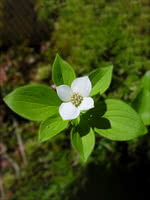Mon-Fri 9am - 5pm Mountain time
Bunchberry vs Anise Hyssop
Cornus canadensis
Agastache foeniculum
NOT AVAILABLE THIS SEASON - MIGHT RETURN
NOT AVAILABLE THIS SEASON - MIGHT RETURN
The Bunchberry, or Quatre-Temps as it is commonly known in Quebec, is an excellent ornamental plant to have in your garden. With star-shaped white flowers in spring and clusters of bright red berries in the fall, this is one of the most refined and hardy groundcovers available. The foliage has ornamental value, with leaves going from a deep green in the spring and summer to a beautiful brick-red in the fall.
Bunchberry is a spreading evergreen perennial with a ground-hugging habit of growth. This plant is not well suited for urban areas close to streetsides, as it is quite intolerant to pollution. It is Canada’s national flower.
According to a poll done by the Master Gardeners of Ontario, it is one of the most recognizable Canadian flowers.
Its flowers grow with elastic petals and "fire" its pollen with the force of 2000-3000 times the force of gravity.
Anise Hyssop is a native perennial wildflower known for its fragrant spikes of small purple flowers. This plant is an excellent source of nectar and is highly attractive to a variety of bees and other pollinators. Deadheading spent flowers will encourage more blooms throughout the season.
Its aromatic leaves release an anise-like (licorice) scent when crushed. Both the leaves and seeds are edible and have been used in teas and as flavouring. Leaves can be harvested at any time, though the oil content is highest just past full bloom. Deer tend to avoid Anise Hyssop because of its strong-smelling leaves. This makes it a useful plant for positioning as a protective border around more vulnerable species.
Anise Hyssop spreads by seeds and rhizomes, but is less aggressive than other members of the mint family and is easy to remove if needed. Historically, it was planted in large numbers as a honey plant to support apiaries. Birds also feed on its seeds, adding to its ecological value.

